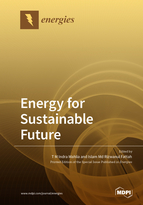Energy for Sustainable Future
A special issue of Energies (ISSN 1996-1073). This special issue belongs to the section "B: Energy and Environment".
Deadline for manuscript submissions: closed (31 March 2021) | Viewed by 37927
Special Issue Editors
Interests: sustainable energy; energy and fuels; renewable energy; techno-economic analysis and life-cycle cost analysis
Special Issues, Collections and Topics in MDPI journals
Interests: renewable energy; emissions; nanoparticles; combustion; alternative fuel; machine learning; sustainable materials
Special Issues, Collections and Topics in MDPI journals
Special Issue Information
Dear Colleagues,
Energy and the environment are interrelated to one another, and they are one of the important factors that influence the development of societies. The pollution of the environment without taking into account various consequences has become one of the most important global issues today. This environmental pollution is mainly the result of increases in economic activities, population, transportation, electricity generation, agriculture, forestry, and land use. The exigency of energy for these activities, the rapidly rising price of petroleum oil, the deleterious effect of greenhouse gases, and the quest for energy security have steered our attention towards sustainable sources of energy. It is fundamental to find innovative solutions that are sustainable from the perspective of energy management and environmental protection technologies. This will provide a promising future in terms of energy sources meeting energy demand, together with maintaining the environment. This Special Issue solicits original research articles as well as critical review articles that cover relevant up-to-date topics related to energy and environmental technologies which have become established ways of thinking, unifying the various methodologies. This “Energy for Sustainable Future” Special Issue in Energies is dedicated to sharing ideas in the area of energy and environment and advancing knowledge among practitioners, scientists, researchers, policymakers, and professionals to nurture innovative ideas required to solve problems in energy and environment for a sustainable future.
Prof. Dr. T M Indra Mahlia
Dr. Islam Md Rizwanul Fattah
Guest Editors
Manuscript Submission Information
Manuscripts should be submitted online at www.mdpi.com by registering and logging in to this website. Once you are registered, click here to go to the submission form. Manuscripts can be submitted until the deadline. All submissions that pass pre-check are peer-reviewed. Accepted papers will be published continuously in the journal (as soon as accepted) and will be listed together on the special issue website. Research articles, review articles as well as short communications are invited. For planned papers, a title and short abstract (about 100 words) can be sent to the Editorial Office for announcement on this website.
Submitted manuscripts should not have been published previously, nor be under consideration for publication elsewhere (except conference proceedings papers). All manuscripts are thoroughly refereed through a single-blind peer-review process. A guide for authors and other relevant information for submission of manuscripts is available on the Instructions for Authors page. Energies is an international peer-reviewed open access semimonthly journal published by MDPI.
Please visit the Instructions for Authors page before submitting a manuscript. The Article Processing Charge (APC) for publication in this open access journal is 2600 CHF (Swiss Francs). Submitted papers should be well formatted and use good English. Authors may use MDPI's English editing service prior to publication or during author revisions.
Keywords
- sustainable energy technologies
- bioenergy and biofuels
- energy and environmental impact
- nanotechnology for Green Energy and the environment
- waste to energy
- energy efficiency in the built environment
- adoption of clean energy and energy security
- CO2 capture and storage
- energy policy and economics
- air pollution policy







